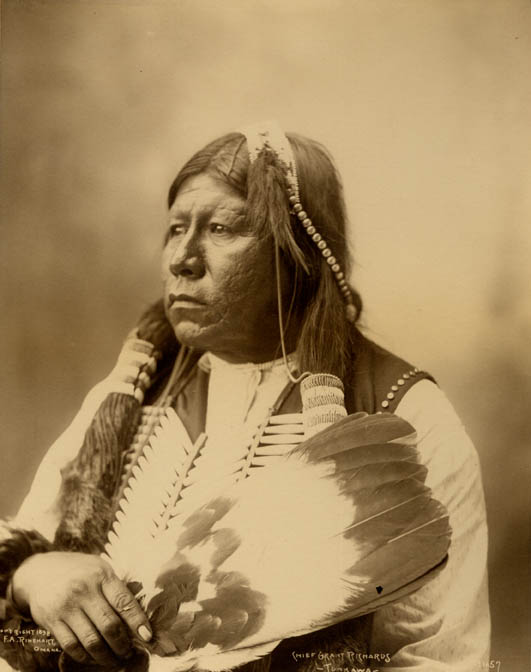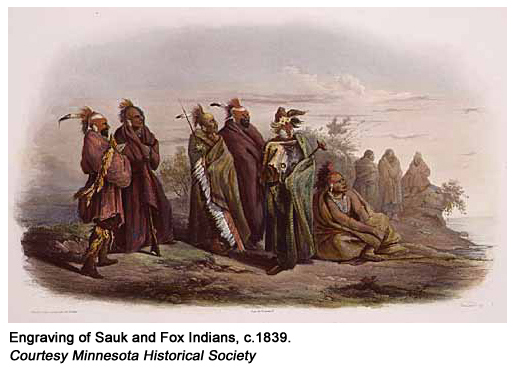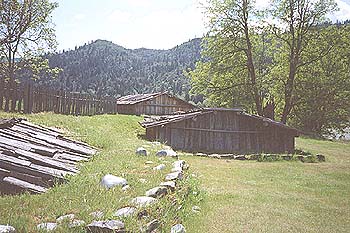|
|
Canku Ota |
|
|
(Many Paths) |
||
|
An Online Newsletter Celebrating Native America |
||
|
October 5, 2002 - Issue 71 |
||
|
|
||
|
This Date In |
||
|
North American Indian History |
||
|
from On This Date in North American Indian History at http://americanindian.net |
||
| Oct. 5, 1838: | Rev. Jesse Bushyhead, and almost 1000 CHEROKEEs begin their emigration to the Indian Territory. Many of the CHEROKEEs in the group are Baptists. They will be allowed to stop on Sundays, so they can conduct religious services. Their march will be delayed almost a month because of thick ice on the Mississippi River. Eighty-two member of this group will die before they reach the Indian Territory on February 23, 1839. |
|
|
|
| Oct. 6, 1986: | Today, Congress will designate the path the NEZ PERCE took in their flight from the Army in 1877 as "the NEZ PERCE Historical Trail." |
|
|
|
| Oct. 7, 1861: | Today, with Albert Pike, the CHEROKEEs will sign a treaty with the Confederacy in Park Hill on the CHEROKEE Reservation in Indian Territory. The agreement will be almost the same as that of the CREEKs signed on July 10, 1861. Living up to their word, 3 Indian delegates would sit in the Confederate Congress throughout the war, something hinted at by the United States, but never implemented. Pike will present the CHEROKEEs with a special flag for their use during the war. |
|
|
|
 "Chief Grant Richards (Tonkawa)" Photograph by F. A. Rinehart, 1898 © Omaha Public Library, 1998 |
|
| Oct. 8, 1779: | El Mocho was an APACHE; but, he was captured by the TONKAWAs. His bravery and natural leadership abilities, eventually led the TONKAWAs to make him their Principal Chief. Today, he will meet with Spanish Governor Athanase de Mezieres in San Antonio. They will sign a peace treaty; and, El Mocho (Spanish for mutilated) will be honored with a Medal of Honor. The peace would only last for a few years. |
|
|
|
| Oct. 9, 1805: | The "SHOSHONIE" guide leaves Lewis & Clark today. |
|
|
|
| Oct. 10, 1918: | The First American (Indian) Church is incorporated in El Reno, Oklahoma, today. Original members include, CHEYENNEs, APACHEs, PONCAs, COMANCHEs, KIOWAs, and OTTOs. |
|
|
|

|
|
| Oct. 11, 1842: |
John Chambers, representing the United States, and the SAUK & FOX Indians sign a treaty today at their tribal headquarters in Iowa. The indians will receive over $800,000 to cede their lands in Iowa and to move to new lands along the Missouri River. (7 stat.596) |
|
|
|
| Oct. 12, 1824: | Today, the CHEROKEE Legislative Council passes a law which requires the loser in any court cases appealed from the district level to the CHEROKEE Superior Court, to pay a fee equal to 6% of the judgement in the case. This fee would go into the CHEROKEE Treasury. |
|
|
|
| Oct. 13, 1864: |
Little Buffalo, with 700 of his fellow COMANCHEs, and KIOWAs, launched a series of raids along Elm Creek, ten miles from the Brazos River, in north-western Texas, today. Sixteen Texans and perhaps, twenty Indians will be killed in the fighting with the settlers, and the rangers, in the area. |
|
|
|
| Oct. 14, 1880: | Victorio's APACHEs are attacked by the Mexican army near Tres Castillos, in Chihuahua, Mexico. Victorio will be shot, and killed by a Mexican sharpshooter. Many of his followers will be killed, as well. The Mexicans will report killing seventy- eight men, and capturing sixty-eight women and children. |
|
|
|
| Oct. 15, 1615: | Today, Samuel de Champlain, 12 Frenchmen, and many of his HURON allies, attack the IROQUOIS town of Onondaga. Champlain will be wounded, and several HURONs will be killed. Champlain will give up the attack. Because of Champlain's actions, the IROQUOIS will fight the French for years to come. |
|
|
|

The Hoopa lived in cedar plank houses, or xontas. These homes were built for comfort and not defense - they remained cool in the summer and warm in the winter, and were the site of much of the daily Hupa activities. |
|
| Oct. 16, 1891: | President Harrison, by Executive Order today extends the Hoopa Valley Indian Reservation along the Klamath River to the Pacific Ocean, except for lands ceded elsewhere. |
|
|
|
| Oct. 17, 1863: | Kit Carson has been conducting a campaign against the NAVAJOs who have not reported to their assigned reservation. This will be called the Canyon de Chelly Campaign. Carson will effect a scorched earth policy, trying to starve the NAVAJOs into submission. Today, 2 NAVAJOs will appear at Fort Wingate, in western New Mexico, under a flag of truce. One of the two is El Sordo, brother to NAVAJO leaders Barboncito, and Delgadito. He will propose that the NAVAJOs live next to the fort, so the soldiers can keep an eye on them at all times. They still do not wish to move away from their homelands to the Bosque Redondo Reservation. The Army will turn down the proposal, and insist the NAVAJOs go to the reservation. |
|
|
|
| Oct. 18, 1820: |
Today, a treaty will be negotiated between Andrew Jackson and the CHOCTAWs. The CHOCTAWs will give up lands in Mississippi for land in western Arkansas. Part of the lands that Jackson promised to the Indians belonged to Spain, or were already settled by Europeans. This would be called the Treaty of Doak's Stand. Chief Pushmataha will be one of the signers. |
|
|
|
|
For Information on This Date in Canada visit our friends at: |
|
Canadian
Aboriginal News |
|
|
||
|
|
||
| Canku Ota is a free Newsletter celebrating Native America, its traditions and accomplishments . We do not provide subscriber or visitor names to anyone. Some articles presented in Canku Ota may contain copyright material. We have received appropriate permissions for republishing any articles. Material appearing here is distributed without profit or monetary gain to those who have expressed an interest. This is in accordance with Title 17 U.S.C. section 107. | ||
|
Canku Ota is a copyright © 2000, 2001, 2002 of Vicki Lockard and Paul Barry. |
||
|
|
|
|
|
The "Canku Ota - A Newsletter Celebrating Native America" web site and its design is the |
||
|
Copyright © 1999, 2000, 2001, 2002 of Paul C. Barry. |
||
|
All Rights Reserved. |
||
